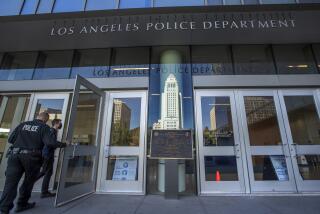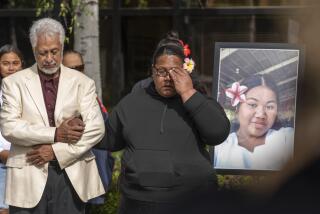A complex picture emerges from Westlake shooting
Time, an increased police presence and intervention by community workers from churches and social service agencies have helped restore peace to the Westlake neighborhood convulsed by violent protests that followed the police shooting of an allegedly inebriated man reportedly threatening passersby with a knife.
Two Sundays ago, three LAPD bicycle officers were flagged down and told that a man with a knife had stabbed someone near 6th Street and Union Avenue, a busy shopping district in a densely populated, mainly immigrant neighborhood. When they arrived, they reportedly found 37-year-old Manuel Jamines, a Guatemalan immigrant, menacing two women with a knife. One of the women told police that Jamines had blood on his hands and had tried to stab her and her pregnant companion. He reportedly was unsteady on his feet as the three officers approached and ordered him in both English and Spanish to drop his weapon. The officers say that, instead, he lunged toward them with the knife over his head. Officer Frank Hernandez, a 13-year veteran, shot Jamines twice, and he died at the scene.
Several nights of violent protests ensued, and some people — most from the area around 6th and Union — allege that the LAPD mistreats neighborhood residents and believe Jamines should have been subdued by nonlethal methods.
An internal LAPD investigation now underway ultimately should provide the facts on whether the officers who encountered Jamines had any realistic alternative to firing. In the interim, a number of important things are clear.
This is a new Los Angeles Police Department — one that not only has reformed itself according to the Christopher Commission’s recommendations and the requirements of the federal consent decree imposed in the wake of the Rampart scandal, but also one that continues to learn as it goes. The police riot that broke up an immigrant rights rally in MacArthur Park was the low point of Chief William J. Bratton’s tenure, but the department’s response — a thorough report quickly made public and discipline for the command officers responsible — was a high point.
Its lessons clearly informed the LAPD’s response to the Westlake unrest. So, too, Chief Charlie Beck’s comments were a striking departure from the department’s historical defensiveness in such incidents. Three days after the shooting, Beck spoke at a mainly hostile community meeting, patiently waiting out the boos and taunts to explain the LAPD’s position and procedure.
The chief subsequently told The Times that the neighborhood’s violent response had taken him by surprise. “This is about so much more than just this shooting,” he said. “Our challenge is to figure that out and to understand what it is really about. We’re still working to peel back those layers.”
His thoughtful response points to another reality: Policing this astonishingly varied city is and will remain hellishly complex. Most Angelenos think of the areas west and southwest of downtown — neighborhoods whose population density exceeds some parts of Manhattan — as immigrant Latino enclaves. In fact, they’re the point of entry for a dizzying array of newcomers from all over Mexico and Central America. The neighborhood around 6th and Union, for example, is tightly knit and almost entirely Guatemalan. Even though all three of the officers who responded that day happened to be Latinos and Spanish speakers, Jamines reportedly understood that language poorly. Like many Guatemalans, his native tongue was a dialect of the Mayan highlands.
The recession has hit 6th and Union hard. Day labor on construction projects has dried up; many households have relied on the income of mothers and sisters. Many of them clean houses, but many of the families who employ them also have cut back on their days and hours. The LAPD’s efforts to control street vendors and to crack down on public drunkenness — both of which have increased amid economic want — all went into fueling the protests.
Finally, there’s the question of whether officers could have avoided a fatal shooting. As bicycle officers, they weren’t carrying Tasers; to have gotten close enough to use pepper spray on Jamines might have placed them in danger. Some have wondered whether Jamines could have been shot in the arm or leg. Remember, though, that real handguns — as distinct from cinematic ones — are hardly precision weapons. If Hernandez had missed, a bullet would have gone whizzing down a street crowded with shoppers.
And if Jamines had bolted into the crowd with his knife and slashed someone, what kind of conversation would we be having now?
timothy.rutten@latimes.com
More to Read
Sign up for Essential California
The most important California stories and recommendations in your inbox every morning.
You may occasionally receive promotional content from the Los Angeles Times.









